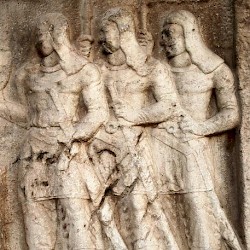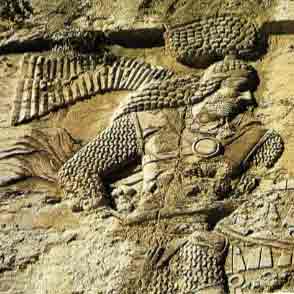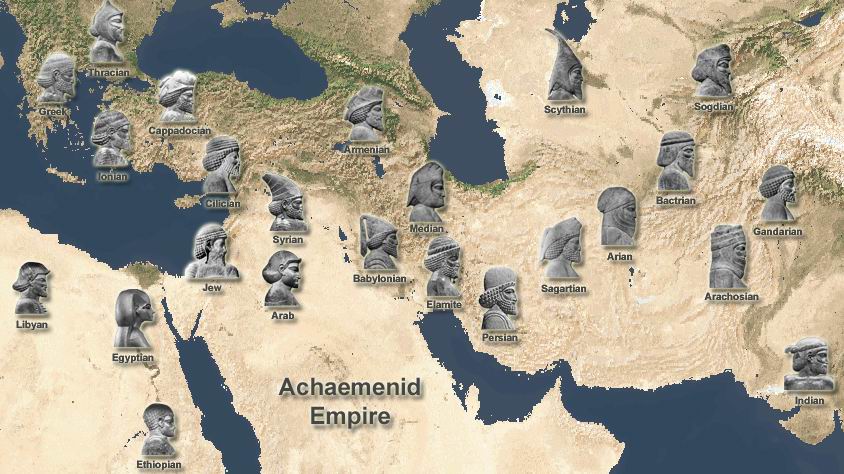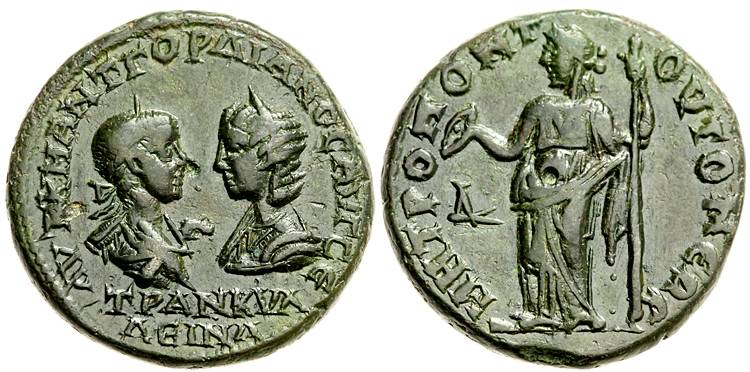14. THE EARLY SASANIAN ARMY.
Historical evidence for the early Sasanian army is scarce, but much evidence has survived from the late Sasanian era, either in original Middle Persian texts or in medieval Arabic or New Persian translations and quotations. By the late Sasanian era, there was in circulation in the Sasanian empire a truly imposing amount of war manuals, treatises and the like, and from what’s remained of them, added to epigraphic sources of the III century (like the ŠKZ) and texts from ancient Graeco-Roman authors, modern scholars have been able to draw a rough sketch of the early Sasanian military.
Ardaxšir I was first and mainly a warlord who tanks to his military abilities rose first to the throne of Pārs and then to the throne of Iran, and who spend practically all his life in campaign on a horse, expanding constantly his territories in every possible direction.
The Middle Persian word for “army” is
spah. The C-i-C of the army was of course the Sasanian
šahanšah himself, and both Ardaxšir I and his son and heir Šābuhr I commanded their armies in the field. Immediately under him, the second highest echelon was that of
Ērān spāhbed, literally “general of the Iranians”, a post which was always held by a member of the
wuzurgān; scholars believe that the
Ērān spāhbed was not actually a commanding officer, but rather a sort of “minister for war” in charge for the overall supervision of the army and with the key responsibility of conducting peace negotiations in the name of the
šahanšah. The commander officer of an army assembled for a campaign received the title of spāhbed (general). In the ŠKZ the old Parthian title of
aspbed (“Master of Horse”, chief of the cavalry) is still attested, although under the Sasanians it did not have the same importance as under the Arsacids, when the aspbed was the second highest ranking commander after the king himself. In later Sasanian texts, instead of this title a new title appears, that of
savārān sardār (Chief of the Cavalry). Another title attested is that of
paygān sālār (Chief of the Infantry); these two titles were probably the Iranian equivalents of the late Roman posts of
magister equitum and
magister peditum respectively; and thus must’ve been mostly administrative posts.
A detail of Šābuhr I’s rock relief of Bishapur III in Fārs, showing infantry.
A very high-ranking post in the ŠKZ inscription is that of
hazārbed, which under both Ardaxšir I and Šābuhr I was held by a certain Pābag. His rank was high enough to be listed immediately after the princes of the royal family, and before the
wuzurgān. Scholars believe that his responsibility was mainly to ensure the king’s personal safety; and that thus he commanded the royal guard and the forces raised in the royal estates; he had to be a person who enjoyed the king’s trust, and thus the
hazārbed appears sometimes in sources as leading armies in campaign. In the ŠKZ, the
Ērān spāhbed is listed among the members of Ardaxsir I’s court, but not among the members of Šābuhr I’s court, while in the latter’s court we find an
aspbed, which does not appear amongst Ardaxsir’s courtiers; according to the scholar Shapur Shahbazi, it’s probable that under Šābuhr I, the
hazārbed took over the responsibilities of the
Ērān spāhbed, although this title reappears again in the inscription of Narseh at Paikuli, dated to the last decade of the III century CE.
British reenactor Nadeem Ahmad in the full garb of a Sasanian spāhbed.
The chief minister of the Sasanian
šahanšah was the
wuzurg framādār (although this title is not attested under the first two Sasanian monarchs), which would often also fulfill military command posts under later Sasanian kings. This sort of “prime minister” was usually a member of the
wuzurgān, and in Islamic times the Abbasid caliphs would revive the office under the Arabic name of
wazīr (from whence the English word “vizier”). This title though is not attested in any surviving source from the III century CE.
Another post in the central organization of the army was the
Ērān ambāragbed, the “chief of army depots”, in charge of supplying the army, while the
pushtigbān sālār was probably the commander of the royal guard (a substantial force of elite heavy cavalry, and thus an army on its own); although again the office must’ve not existed before Šābuhr II’s reign at the earliest (when the very word
pushtigbān is first attested). According to the Zoroastrian
Denkard, the Sasanian military had even a corps of veterinaries (the
stōr bizešk) charged with caring after the health of the horses of the cavalry.
There were also territorial commands, of which the one that is already attested since Arsacid times and was kept by the Sasanians was that of
marzbān. Again, there’s some controversy about this post. It was mainly of a military nature, although
marzbānān also held civilian attributions. Most scholars believe that the
marzbān was the military governor of a border province (a “march”), and thus the commander of the military forces stationed there as garrisons and with the faculty of mobilizing its non-permanent forces (militias, allied tribes, noble levies, etc.) in case of foreign attack. The problem (in my opinion) is that then most scholars list the provinces ruled by a
marzbān and include interior provinces like Spāhān, Pārs and Kirmān which were not under any foreign menace (well, Pars was attacked across the Persian Gulf by Arab tribes in the early IV century CE). To me, it seems that a
marzbān was just a military governor and that it existed in all provinces, but that in border provinces its post was more relevant, because the in case of foreign attack the
marzbān was responsible for defending the province until the king sent reinforcements. Apart from being military governors, the
marzbānān also acted as civilian governors, but in the ranks under him the civilian and military administrations became divided into separate branches.
A particularity of the Sasanian military, inherited from the Arsacids and which was totally absent from the Roman army was that most of these posts were the patrimonial property of the
wuzurgān. This was the inevitable consequence of the structure of the Iranian society. For example, it was very problematic to appoint a
marzbān to a province if its nobility did not like him, so the post of
marzbān to any given province was usually inherited within the most powerful clan in that province, like in the case of the province of Abaršahr, where the title of
kanārang (local equivalent to
marzbān) became hereditary within the ruling family of Tūs, which became known as the Kanarangiyan. Some scholars also believe that at one given time the post of
aspbed also became hereditary within the Ispahbudhan clan.
The above passages already suggest that from the start the Sasanian army, although it retained most of the core Arsacid tactics and doctrines, was organized in a very different way than its predecessor. It had a central command structure, with even its own logistical branch, something completely unattested for the Arsacid period. Over time, the tendency was to increase the number of men in the royal forces, allowing the
šahanšah to have less dependence of the forces of the great clans. But according to modern scholars, in the VI century CE after the reforms of Xusrō I the royal army still amounted to less than half of the total armed force available to the Sasanian kings. Under the first two kings of the dynasty, the situation can’t have been much different than it was under the last Arsacids, with the overwhelming majority of the army coming from the levies among the great clans.
Sasanian cavalry depicted in Šābuhr I’s rock relief at Bishapur III.
Cavalry remained the core of any Iranian army under the Sasanians, but its composition varied with respect to that of the Arsacid era. Scholars believe that little (if any) light cavalry archers were raised in the Iranian plateau, and that now most of the light horse archers of the Iranian armies were provided by allies, vassals and mercenaries (Albanians, Kushans, Kidarites, Hephtalites, Turks, etc), especially from nomadic Central Asian peoples. According to late Sasanian sources from the Vi century CE, Ardaxšir I divided the population into four states: priests, warriors (
artēštārān), husbandmen and peasants, and finally artisans and traders. Only the
artēštārān (the nobility) could belong to the cavalry, some of it was provided by the king himself, some of it by the
wuzurgān and their retinues and the rest by the
āzādān, the lesser nobility. This noble cavalry was the flower of Sasanian cavalry, and it was formed by armored horsemen equipped at first in a way lighter that under the Arsacids; the great battle relief of Ardaxšir I against Ardawān V at Ardaxšir-Xwarrah shows Sasanian horsemen equipped with Roman-style mail armor while their Arsacid foes were equipped with an older and heavier lamellar armor. These horsemen were equipped (under Xusrō I) with a
kontos, sword, war axe or mace, a bow an quiver with 30 arrows, a lasso and even a sling. The idea was obviously that this “universal” cavalry could be used to fulfill the roles that in Arsacid times had fulfilled the light and heavy cavalry. In the same relief, horses also appear to be armored not with iron armor, but with a leather or thick cloth mantlet.
Detail of Ardaxšir I’s armor in his victory relief at Ardaxšir-Xwarrah.
Under Šābuhr II in the IV century CE, the trend turned again to favor more heavily protected cavalrymen, as attested by Ammianus Marcellinus in his
Res Gestae.The Sasanian army also differed from its Arsacid predecessor by its increased use of infantry. There were three main types of infantry: light infantry, infantry archers and heavy infantry.
Light infantrymen were called
paygān, and according to Classical authors, they were “pitiable peasants”, poorly armed and with no training, who were only fitted to serve the cavalrymen and to be used as labour forces in sieges and to build fortifications. They were raised by levy from amongst the peasant populations of the estates of the king and the nobility, and they were regarded as mere “cannon fodder” by their leaders. Obviously, they were no match for Roman heavy infantry.
The archers were the elite of the Sasanian infantry. They were masters in area shooting, and their training was geared towards delivering rapid and overwhelming archery fired against selected areas in the battlefield. They usually shot their arrows protected behind large wickerwork and oxhide shields, and they acted in coordination with the cavalry. Battles were usually opened by them by showering the enemy ranks with their arrows, to “soften” them for a cavalry charge. According to Islamic medieval authors, Ardaxšir I was himself an accomplished bowman, and invented a new type of draw which enhanced the speed and strength of an archer’s shots.
Finally, the IV century Roman author Ammianus Marcellinus also wrote about heavy infantry in the armies of Šābuhr II “armed like
mirmillones”, which was a type of Roman gladiator. This means that in Sasanian armies served infantry provided with heavy shields, metal helmets and swords, with some body armor. This heavy infantry came probably (as in late Sasanian times) from the semi-independent Iranian northern mountain tribes of Daylam and Gilan near the Caspian sea which served as mercenaries in the armies of the
šahanšah. There’s also the possibility that under Ardaxšir I these forces included Roman deserters, as implied by Dio and other sources.
The region of Daylam, on the Alborz mountains south of the Caspian sea.
Possibly already under Šābuhr I, the Sasanians began using war elephants, probably as a consequence of the impact they made in their war against the Kushans in Afghanistan and the Indus valley. Against undisciplined or demoralized enemies, they could work miracles. Against the disciplined Roman army, their effectiveness was dubious, although the Sasanians kept using them until the very end.
Like under the Arsacids, the army was organized into divisions (
gund) which were in turn subdivided in “banners” (
drafš), each one identified by their own standard).
Another important difference with the army of the Arsacids that became very obvious since the very early days of the new dynasty was that the Sasanians finally mastered the siege techniques employed by the Romans, which was a very bad development for the Romans. During its first Mesopotamian campaign, the Sasanian army behaved like the Arsacid armies of old, they were only able to surround Roman fortified cities and try to force them into surrendering through hunger; as the Sasanian army had to return to Iran each autumn, these sieges were short and unable to force the well supplied Roman defenders into submission. But in the 238-239 campaign, Ardaxšir I’s army achieved the surrender of Nisibis and Carrhae, heavily garrisoned and protected cities, and in 239-40, Hatra and Dura-Europus also fell into Sasanian hands; this marks a 180 degree turn in the situation; for the first time Iranian armies seemed able to take fortified cities like the Romans did. It’s not sure what happened, but it’s probable that Roman deserters (as implied by Dio, and the imperial legislation passed by Severus Alexander) trained the Sasanians in Roman siege tactics; from this moment on, the Sasanians became as skilled in sieges (both in offense and defense) as the Romans were. A dramatic testimony of this proficiency can be found in the ruins of Dura Europus, the “Pompey of the East”, which was besieged and finally destroyed by a Sasanian army in 256 CE in which almost all siege techniques (including poisonous gas) were used both by the Roman defenders and the Sasanian besiegers.
The Sasanian army also differed from its Arsacid predecessor in that it was much more willing to fight pitched battles than the old Arsacid armies were. If necessary, they could also resort to the old tactics of guerrilla warfare, harassing and scorched earth, but unlike under the Arsacid kings, now the Romans were able to fight many more pitched battles against their Iranian foes.
The IV century Roman soldier and author Ammianus Marcellinus hated the “Persians”, but he admired their “patriotism”. According to him, this was taken to the extreme in Šābuhr II’s army: if a man was found to have deserted to the enemy, his entire family was put to the sword. Ammianus and other late Roman authors also extolled the tenacity of Sasanian armies in sieges; they were fearsome when besieging, but really formidable when besieged. This proficiency of the Sasanian army in sieges becomes already evident under Ardaxšir I and especially under his son Šābuhr I. The propaganda value of Zoroastrian religion was also exploited by the Sasanian kings, who usually carried
mowbedān with them into battle, and sometimes even the
mowbedān mowbed, to help raise the morale of their men.











